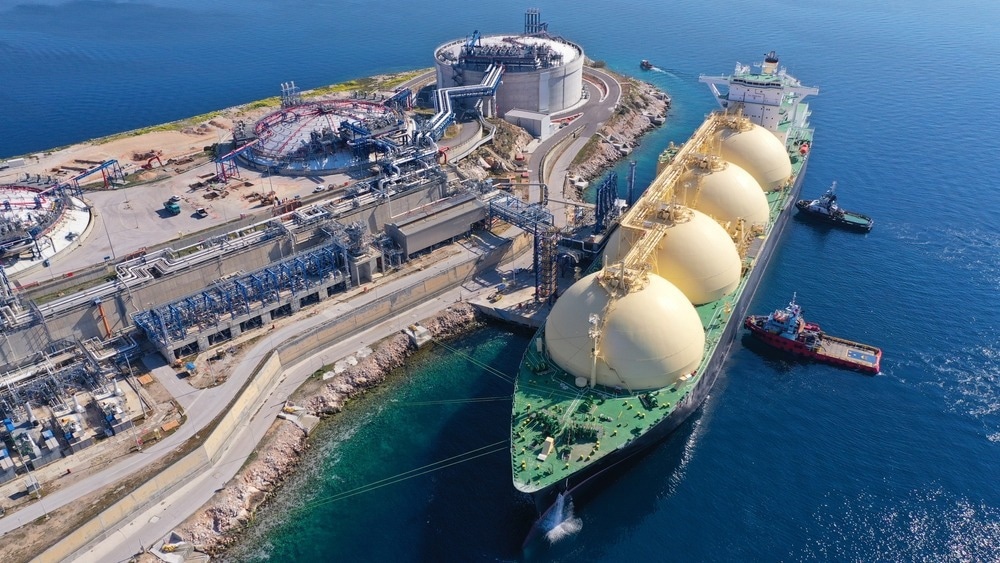In a recent article published in Energy Science & Engineering, researcher Robert W. Howarth comprehensively examined the greenhouse gas footprint of liquefied natural gas (LNG) exported from the United States. The study provided a detailed lifecycle assessment of LNG, focusing on the significant methane and carbon dioxide emissions during production, liquefaction, and transportation. It highlighted LNG's considerable environmental impact and questioned its reputation as a cleaner alternative to coal.

Image Credit: Aerial-motion/Shutterstock.com
Liquified Natural Gas: What is it?
LNG is natural gas cooled to a liquid state at approximately -162 °C for easier storage and transport. The LNG process involves several steps: extraction, liquefaction, transportation, and regasification. Shale gas is commonly extracted in the United States using hydraulic fracturing and directional drilling.
These methods have significantly increased natural gas production. However, they are energy-intensive and release substantial greenhouse gases, particularly methane. Methane has a much higher global warming potential over 20 years than carbon dioxide.
About the Research
In this paper, Howarth aimed to analyze the full lifecycle greenhouse gas emissions of exported LNG from the United States. Since lifting the LNG export ban in 2016, the United States has become the world's largest LNG exporter.
The study examined emissions at every stage of the LNG lifecycle, from shale gas production to end-use combustion, and compared its greenhouse gas footprint to coal. It considered 20-year and 100-year global warming potentials (GWP20 and GWP100). The analysis utilized recent data on methane emissions from shale gas development and considered different types of LNG tankers and their emissions.
Detailed Analysis and Methodology
The researcher used a detailed lifecycle assessment to estimate emissions from shale gas production to combustion by the final consumer. Their assessment included carbon dioxide and methane emissions at each step in the supply chain: production, processing, storage, transport, liquefaction, and regasification. The research relied on nearly one million observations from recent comprehensive analyses and measurements in the United States.
The methodology involved calculating emissions using net calorific values and converting methane emissions to carbon dioxide equivalents using GWP20 and GWP100. The author also considered the energy densities of LNG and heavy fuel oils, assuming that shale gas and LNG primarily comprise methane.
Key Findings and Insights
The outcomes showed that the greenhouse gas footprint of LNG is significantly higher than previously thought. Key findings include that methane emissions from midstream and upstream sources are the main contributors to the LNG footprint, accounting for 38% of total emissions based on GWP20. These substantial emissions stem from the energy-intensive processes involved in shale gas production and LNG liquefaction. The energy-intensive liquefaction process adds another 8.8% to the total emissions, while tanker transport contributes 5.5%, with variations depending on the type of tanker used.
In contrast, LNG's end-use combustion carbon dioxide emissions contribute only 34% of the total greenhouse gas footprint. However, when combined with emissions from the energy used to produce LNG, total midstream and upstream emissions account for 47% of the overall footprint.
Emissions from LNG tankers vary depending on the type of propulsion used. Surprisingly, modern tankers with two- and four-stroke engines generate more greenhouse gas emissions than steam-powered tankers. This is due to methane slippage in the exhaust despite their greater fuel efficiency.
The study also found that LNG's total greenhouse gas footprint is 33% greater than that of coal when analyzed using GWP20. Even when considering a 100-year global warming potential (GWP100), which underestimates the climatic impact of methane, the LNG footprint remained equal to or exceeded coal. This challenges the common perception that LNG is a cleaner alternative to coal. It highlights the significant impact of methane emissions on overall greenhouse gas contributions.
Applications
This research has significant implications for energy policy and climate change mitigation strategies. LNG's high greenhouse gas footprint suggests its role as a transitional fuel toward a low-carbon future may be limited. Policymakers must consider LNG's full lifecycle emissions, particularly methane, when evaluating its environmental impact and determining energy exports and climate policies.
The researcher also emphasized reducing methane emissions from shale gas production. Improving the efficiency of LNG tankers is crucial for mitigating their environmental impact.
Conclusion and Future Direction
In summary, Howarth's study comprehensively assessed the greenhouse gas emissions associated with LNG exported from the United States. The findings highlighted the significant contribution of methane emissions to LNG's overall greenhouse gas footprint, challenging the perception that LNG is a cleaner alternative to coal.
Future work should focus on developing and implementing technologies to reduce methane emissions throughout the LNG lifecycle. Policymakers should also consider these findings when formulating energy and climate policies, ensuring that the environmental impact of LNG is fully accounted for in the transition to a sustainable energy future.
Disclaimer: The views expressed here are those of the author expressed in their private capacity and do not necessarily represent the views of AZoM.com Limited T/A AZoNetwork the owner and operator of this website. This disclaimer forms part of the Terms and conditions of use of this website.
Source:
Howarth, R, W. The greenhouse gas footprint of liquefied natural gas (LNG) exported from the United States. Energy Science & Engineering, 03 October 2024. DOI: 10.1002/ese3.1934, https://scijournals.onlinelibrary.wiley.com/doi/10.1002/ese3.1934